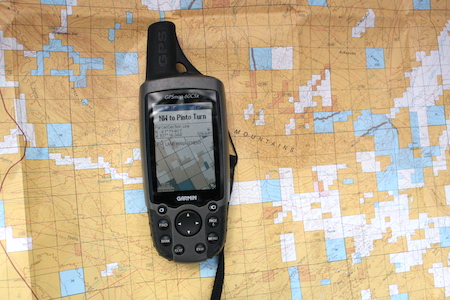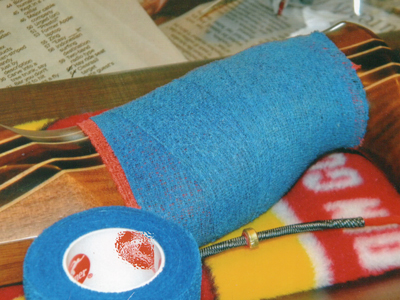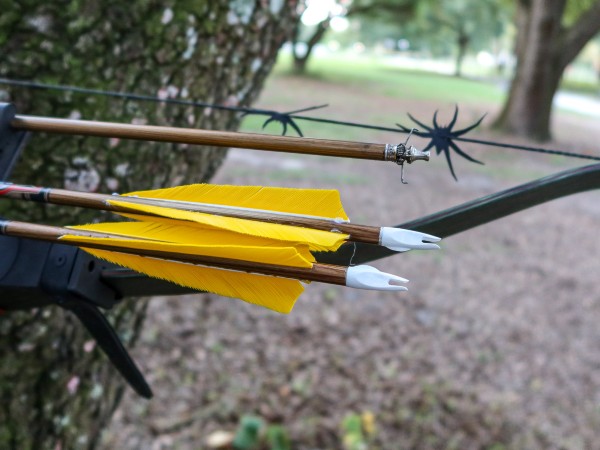The dispatcher’s voice crackled over the radio informing me of a trespasser on a local landowner’s property. I quickly jotted down the description of the vehicle and headed that way. I found the pickup parked along a public road bordering the landowner’s property. A quick look through the windows showed the usual trappings of a hunter: some antelope regulations, a bow case, and a camo sweatshirt. After a cup or two of coffee, I watched the camo-clad hunter returning to his rig. Watching as he crossed the 4-strand barbed wire fence, I could sense he was worried when he saw my green Wyoming Game and Fish Department truck. I’ve learned this is nothing out of the ordinary as the presence of a waiting law enforcement vehicle and accompanying official can get the blood pressure going of anyone, honest or not. Meeting at his truck, he replied to my questioning that he was on public land. Opening his atlas of Wyoming maps on the hood of his truck, the bowhunter’s shaky index finger pointed to a small tan square in an ocean of white-colored private land. The scale was such that it was extremely difficult for him to identify nearby landmarks. A small reservoir a few miles away appeared a mere two inches from our location on the map. I agreed that a person with that map could believe he had stopped on the road right at the public Bureau of Land Management section as indicated on the atlas. Problem was, we were a good mile from the public land.
 He was a decent guy whom I had checked in past bow seasons. He had always been ethical, with an evident passion for bowhunting. But, as I explained to him, the game and fish trespass law does not include any language where a person has to know he is illegally trespassing, and landowners do not have to post their property. A trespass is a trespass. Somehow I had a cell signal and made a quick call to the landowner. To the hunter’s relief, the owner of the property agreed that a warning was in order. More often than not, however, a citation is issued in trespass situations. I advised the man that a good BLM map or an investment in a handheld GPS could save him some big dollars in fines and keep his name out of the local newspaper.
He was a decent guy whom I had checked in past bow seasons. He had always been ethical, with an evident passion for bowhunting. But, as I explained to him, the game and fish trespass law does not include any language where a person has to know he is illegally trespassing, and landowners do not have to post their property. A trespass is a trespass. Somehow I had a cell signal and made a quick call to the landowner. To the hunter’s relief, the owner of the property agreed that a warning was in order. More often than not, however, a citation is issued in trespass situations. I advised the man that a good BLM map or an investment in a handheld GPS could save him some big dollars in fines and keep his name out of the local newspaper.
As a retired Wyoming game warden with 20 years of field experience, I have noticed common violations that some bowhunters fall prey to while pursuing their sport. I’ve seen some egregious unethical behavior over the years, but the times it has involved bowhunters is relatively minuscule, especially the traditional types. A traditional bowhunter obviously is in the sport for the challenge, and bending or breaking the rules takes away some of the challenge, not to mention the ethical considerations. While my experiences are Wyoming-specific, these same violations are encountered in the western states. There may be some different nuances in state laws, but they address similar situations found in Wyoming.
I am still employed with the Wyoming Game and Fish Department, but I am no longer a warden (having opted for a desk job in a moment of insanity). I am a passionate traditional bowhunter and can empathize with my fellow hunter’s plight. This article, I should note, is written through the pen of the traditional bowhunter using the experience of a game warden, and does not necessarily reflect the State’s view.
At the top of the common violation list, especially in the predominantly private eastern half of Wyoming, is illegally trespassing. The story above pretty much sums up 95 percent of the encounters, except a citation is usually issued. Turned-around hunters, sub-par maps, and poor map reading skills are the main cause. Even with a decent map, the hunter needs to ensure the public land has not been sold or swapped since the map was printed. A call to the county assessor with the legal description of the land in question can quickly verify the status.
A close runner-up to trespass violations is failing to properly tag big game animals. In the hunter education courses I have taught, I always emphasized the first thing to do upon a successful harvest is to complete the steps to properly tag an animal. There is a great chance with all of the excitement upon harvesting an animal, a person will forget this requirement (compounded if a storm or darkness is approaching). In Wyoming, tagging consists of detaching the carcass coupon from the main portion of the license, entirely removing the appropriate wedges for the day and month, and signing the tag — all before leaving the site of the kill. The tag has to be visibly attached to the animal, or if the hunter is with the animal, the tag can remain with the hunter. Like the trespass violation (and most all Wyoming game statutes), a person does not have to knowingly break this law.

While undoubtedly many hunters who don’t tag an animal have simply forgotten, a game warden isn’t a mind reader. Years ago, while patrolling the Bighorn Mountains late in the deer season, I came upon a rifle hunter and checked his “slick” license (one that has not been used to tag an animal). He was bemoaning the lack of deer and was hoping he could fill the tag in the last remaining days. This was when the Department used to have the day and month wedges printed on the outside perimeter of the license. I was about to bid him adieu when something shined off the back of the license. Closer inspection revealed a small slit in the wedges for the month and day had been glued back together! He sheepishly admitted to killing a deer earlier in the season. I’m sure if he had been stopped with that first deer in his truck, he would have played the ignorance card — telling the game warden that he thought he could just put a slice in the wedges and didn’t know he had to completely remove the wedges and detach the carcass coupon. Making it to his house, he thought he was home-free to get another deer on the license. He received a citation for failing to properly tag the first deer and a second citation for attempting to take an over limit of deer. A couple of years later, the Department printed the tags with the wedges located on the inside, making it tougher to “semi-tag” an animal.
Wyoming requires a hunter to possess a conservation stamp in addition to his hunting license. Only one stamp is needed, whether or not the person has one or many licenses. For some reason, hunters — mainly nonresidents — frequently fail to have a stamp when checked in the field. Most of them honestly do not know a stamp is required. To prove we actually try our best to alert sportsmen of this requirement, I started carrying the documents a hunter has to use to purchase a license. In numerous places we have printed in bold, large font sizes that a conservation stamp is required. The Department even began inserting notices in the licenses mailed to hunters that they need a stamp. Admittedly, there is a lot to digest when a license shows up in the mail, and I assume the notice gets lost in the excitement and information overload.
Another way bowhunters find themselves in trouble is failing to retain evidence of sex from the animal they harvest. If a hunter has a tag that limits the take to a certain gender, the evidence of sex (sexual organs, udder or head) has to remain with the animal. In the past, the law required that the evidence of sex had to remain attached to the animal; that requirement was often forgotten in the field-dressing process and it made it difficult for a hunter to follow the regulation when boning the meat out to take home in coolers. Now the evidence of sex can go in a baggy in the cooler or the head can stay with the cooler in the back of the truck. The evidence of species has to be apparent, as well.
I should note in the process of bringing the meat and head home, the hunter needs to keep in mind the relatively recent laws enacted to prevent the spread of chronic wasting disease (CWD). This disease affects the central nervous system of the animal; the abnormal proteins that cause this disease are found in the head and spinal tissues of infected animals. CWD is only found in deer, elk, and moose. Many states now restrict which parts of those animals they allow to be transported within their jurisdiction, and Wyoming is no exception. In a nutshell, the parts that may be infected (head and spinal column) have to remain at the site of the kill and cannot be transported anywhere in Wyoming, unless those parts end up in a landfill. If you take your animal to a taxidermist or a processor, they will (or should) deposit the potentially infected parts in a landfill.
Whole carcasses are not allowed to go out of the state. It would be a good idea to check with your home state to see what restrictions may apply. My cousin, a traditional bowhunter from Minnesota, joins me on my Wyoming bow hunts. One year, after a successful hunt, he was contacted by the Minnesota Department of Natural Resources inquiring how he had disposed of his Wyoming deer and what parts he had brought into Minnesota. Obviously, the Minnesota DNR takes the threat of CWD seriously.
So, let’s say you have just taken the elk of your dreams. How do you legally get the head back with you when Wyoming requires it goes to a landfill or remains at the site of the kill? Besides the option of going directly to a Wyoming taxidermist, the law allows you to remove the skull plate as long as you remove all of the meat and brain tissue.
As far as transporting a big game animal out of state, the person who killed the animal has to be with the animal. Every day of the season, a game warden encounters successful nonresident hunters travelling back to their home state. Upon inspection, while they may have taken care of all of the animals properly, the warden sometimes finds a tagged animal belonging to someone who is not present. For a variety of reasons the hunter had to leave early (sick wife, work beckoned, etc.). The law requires a Wyoming interstate game tag be attached to the animal if the hunter who harvested it is not present and the animal is going out of state. These tags can be obtained at regional offices or from game wardens (most taxidermists and meat processors have them, too). Each tag costs $8.00 and requires signing an oath that the animal was harvested legally.
It is interesting to note that Wyoming’s legislature has never enacted a field-sobriety check point law, and roadblocks are considered illegal in the state. However, the state takes a high view of its wildlife resources. The legislature has created a check station law, whereby all hunters must stop at these check points — even if they have not harvested an animal (this includes hunters going to their destination). The check stations do not necessarily have to be a large affair where interstate travelers are stopped. A game warden can set up a few signs on secondary or remote roads and stop hunters as they come by. I’ve sat at many check stations and watched with wonder as hunters, decked-out in full camo, speed by. After I pull them over, most of them say they didn’t think they had to stop as no game animals were in their vehicles. A few have game animals with them – a few of those don’t have licenses or have an untagged animal. When the muddy truck with camouflaged men in the cab blows through a check station, the warden won’t be far behind with red and blue lights shining. Again, it would be terrific if a game warden could read the thoughts of the hunter as he rolls by, divining that no animals are in his truck.
These violations make the top of the list, but there are many more laws of which a bowhunter may run afoul. The West offers a diverse, abundant mix of small game, game birds, and big and trophy game animals from the high deserts to above timberline. With this diversity comes an inherent variety of laws and regulations to help manage the wildlife. It behooves the bowhunter to take some time to study the regulations before going afield. A call to the local game warden or biologist can clarify confusing regulations.
I thoroughly enjoyed my field experience as a warden and found much satisfaction in finding the truly bad guys. Those who would spotlight our winter ranges for trophy animals or take over limits of big game animals deserved every punishment the law could mete out. The distasteful part of the job was writing tickets to those honest hunters who should have known better. As dedicated bowhunters we certainly read, study, and practice to hone our skills; a little extra time spent getting familiar with the game laws in the state we hunt should be part of our preparation.
Sidebar: Obviously a citation has financial consequences, but it can also affect hunting privileges. In Wyoming, a typical hunting citation will cost the hunter around $200 to $400. If the situation is such that the game warden feels the state is owed restitution for the animal (waste, abandonment, etc.) the hunter will be required to appear before the court where the judge may impose a fine and restitution for the animal. Restitution for antelope costs $3,000; deer will run the offender $4,000; an elk will drain the bank account to the tune of $6,000. If a bighorn sheep is involved, the hunter will face a loss of $15,000.
If those figures aren’t enough to keep you on the straight and narrow, an offending hunter also faces the chance of losing his hunting privileges, and losing the animal he harvested. Depending on the violation, the court may take anywhere from a few months up to a life-time loss of privileges. All states, except Nebraska and New Jersey, are currently members, or are in the process of joining, the Interstate Wildlife Violator Compact. This means if privileges are revoked in the state where the violation occurred, those privileges will be revoked in ALL of the member states.







Leave A Comment